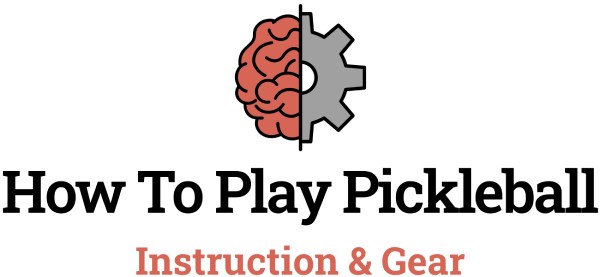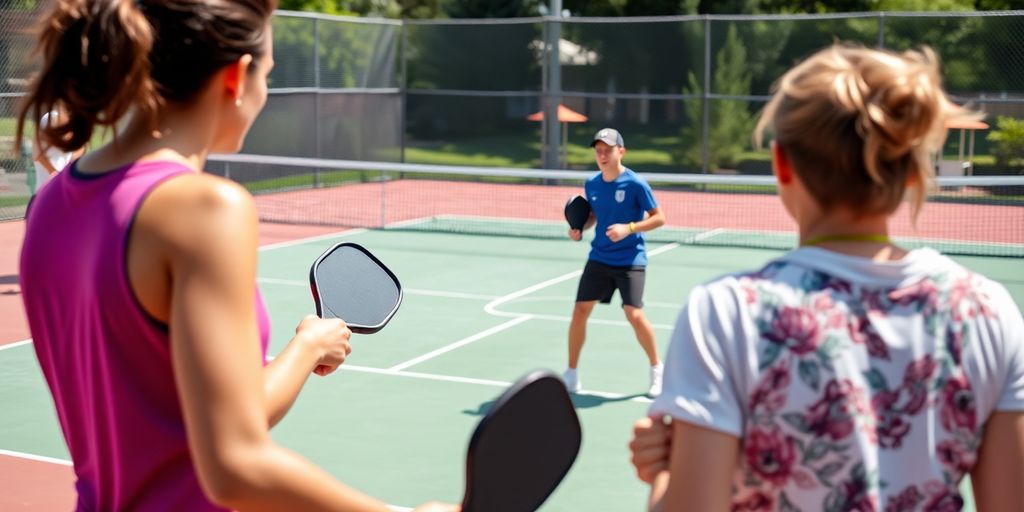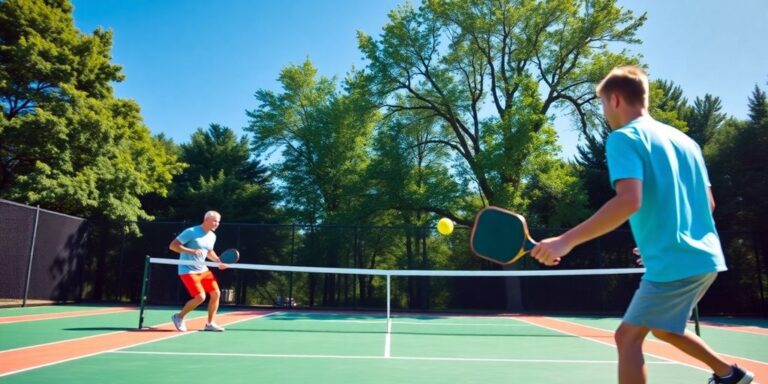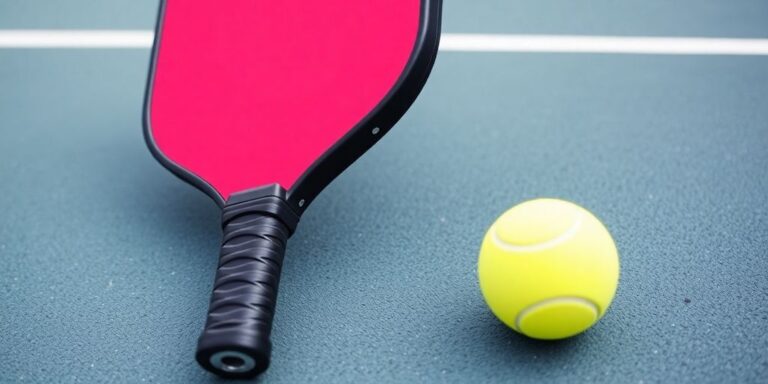Pickleball is one of those sports that’s easy to get hooked on. It’s got this cool mix of tennis, badminton, and ping-pong all rolled into one. But if you’re new, some rules might seem a bit puzzling at first. One of the biggies is the double bounce rule. It’s a key part of the game that can really change how you play. So, what’s this rule all about? Let’s break it down and see why it’s such a game-changer.
Key Takeaways
- The double bounce rule means each team must let the ball bounce once on their side after the serve before hitting it.
- This rule helps to keep the game fair and lets rallies last longer.
- It stops players from rushing the net right after the serve, making the game more strategic.
- Understanding this rule can boost your pickleball skills and make the game more fun.
- Newbies might find this rule tricky at first, but with practice, it becomes second nature.
The Basics of the Double Bounce Rule
Definition and Explanation
In pickleball, the Double Bounce Rule is a fundamental aspect that shapes the flow of the game. This rule mandates that after the serve, the receiving team must let the ball bounce once before returning it, and then the serving team must also allow the ball to bounce once before hitting it back. These two mandatory bounces are what give the rule its name. Once each side has allowed the ball to bounce, players are free to volley or play the ball off a bounce. This rule is designed to prevent immediate aggressive net play and to encourage longer rallies.
Importance in Gameplay
The Double Bounce Rule is crucial because it levels the playing field, making the game more accessible to players of all skill levels. By requiring the ball to bounce on both sides before volleys can occur, it promotes strategic thinking and patience. This rule helps in prolonging rallies, thus making the game more engaging and competitive. It also ensures that players develop a well-rounded skill set, as they must be adept at both volleys and groundstrokes.
Common Misunderstandings
Despite its simplicity, the Double Bounce Rule is often misunderstood. Some players mistakenly believe that they can volley immediately after the serve, which is not the case. Another common error is thinking that the ball must bounce twice on one side before it can be returned. Clarifying these misunderstandings is essential for smooth gameplay. Remember, the rule is about one bounce per side after the serve, not two bounces on the same side.
The Double Bounce Rule is not just a guideline; it’s a core part of what makes pickleball unique and enjoyable. Embracing this rule can enhance your gameplay and appreciation for the sport.
How the Double Bounce Rule Affects Strategy

Encouraging Longer Rallies
The double bounce rule is like a built-in rally extender. By requiring both teams to let the ball bounce once before volleys, it slows the game down just enough to make things interesting. This rule not only makes the game more accessible for beginners but also promotes longer rallies. Players can’t just rush the net and smash the ball back immediately, which means more back-and-forth action and a chance for everyone to get involved. It’s a great equalizer, giving both sides time to set up their shots and plan their next move.
Impact on Net Play
Net play in pickleball is all about timing and positioning. The double bounce rule changes the dynamics here significantly. Players have to be more patient and strategic because they can’t just park themselves at the net from the get-go. Instead, they need to hang back a bit and wait for that second bounce. This creates a more thoughtful approach to advancing up the court. The rule ensures that players can’t dominate with aggressive net play right off the bat, which adds an extra layer of strategy to the game.
Strategic Positioning
Positioning on the court becomes a chess match thanks to the double bounce rule. Players need to think ahead, predicting where the ball will land and where they need to be for the next shot. This rule encourages players to spread out and cover more ground, rather than crowding the net. It’s about finding that sweet spot where you can react quickly to whatever your opponent throws your way. Smart positioning can be the difference between winning and losing a point, especially when it comes to avoiding faults from stepping into the non-volley zone too early.
Common Mistakes with the Double Bounce Rule

Misinterpretation of the Rule
A common pitfall for many players is misunderstanding the double bounce rule. Some assume it only applies to the serve, but it actually dictates that both the serve and the return must bounce before volleys are allowed. This rule is crucial because it levels the playing field by preventing aggressive net plays right after the serve. Misinterpreting this can lead to unintended faults and lost points.
Foot Faults Related to the Rule
Foot faults are another frequent issue, often occurring when players step over the line before the ball is served. This mistake not only results in a fault but also disrupts the flow of the game. Players should always be mindful of their positioning, ensuring their feet are behind the baseline until the ball is struck.
Avoiding Early Volleys
Many players are eager to jump into volleys, forgetting the necessary bounces. This eagerness can lead to early volleys, which are faults if the ball hasn’t bounced on each side once. To avoid this mistake, players should practice patience and focus on the rhythm of the game, ensuring each ball has bounced twice before engaging in volleys.
Mastering these elements is key to enhancing gameplay and ensuring a smooth match. With practice, players can avoid these common pitfalls and play more strategically.
Mastering the Double Bounce Rule for Beginners
Tips for New Players
Getting the hang of the double bounce rule can be a bit tricky at first, but don’t worry, it’s all part of the learning curve. The key is to always remember that the ball must bounce once on each side before volleys are allowed. This rule slows down the game initially, giving you more time to think about your next move. Here are some tips to help you get started:
- Practice Patience: Wait for the ball to bounce before making your move. It gives you a moment to strategize.
- Positioning is Key: Stay alert and ready to move. Good positioning helps you respond quickly once the ball bounces.
- Communicate with Your Partner: If you’re playing doubles, talk with your partner about who will take the shot after the bounce.
Practicing the Rule
To really get comfortable with the double bounce rule, practice is essential. Set up drills that focus on letting the ball bounce and then returning it. Here’s a simple practice routine:
- Bounce and Return: Have a partner serve the ball to you. Let it bounce, then return it. Repeat this back and forth.
- Footwork Drills: Work on moving quickly to the ball after it bounces. Quick feet will help you get into position faster.
- Simulated Games: Play practice games focusing solely on the double bounce rule. This helps reinforce the habit.
Building Confidence
Confidence comes with time and practice. As you get more comfortable with the double bounce rule, you’ll find that it actually enhances your game. It encourages you to think more strategically about your shots and positioning.
Remember, every player was a beginner once. Mistakes are part of the learning process. Embrace them, learn from them, and you’ll see improvement over time.
By focusing on these elements, beginners can turn what might seem like a restrictive rule into an opportunity for strategic growth and improved gameplay. As you get better, you’ll start to see how the double bounce rule not only levels the playing field but also adds a fun challenge to the game.
Advanced Techniques Involving the Double Bounce Rule
Using the Rule to Your Advantage
The double bounce rule isn’t just a beginner’s guideline; it’s a strategic tool in advanced play. Mastering this rule can open up new avenues for controlling the game. After the initial two bounces, players can choose to volley or let the ball bounce, creating a dynamic shift in play style. This choice allows players to dictate the pace and rhythm of the game, keeping opponents guessing and off-balance.
Advanced Positioning Strategies
Positioning on the court can make or break your game. Advanced players use the double bounce rule to set up their positions effectively. Here are some key strategies:
- Anticipate the Bounce: Always be ready for the ball to bounce, especially after the serve. This helps in maintaining a strong defensive position.
- Stay Agile: Quick footwork is crucial. Move swiftly to adjust your position based on the ball’s bounce.
- Control the Net: After the double bounce, aim to control the net area to put pressure on your opponents.
Incorporating Spins and Angles
Adding spins and angles to your shots can significantly enhance your gameplay. The double bounce rule gives you the time to plan these tricky shots. By using topspin or backspin, you can manipulate the ball’s trajectory, making it harder for your opponents to predict and return. Angled shots can also be effective, forcing opponents to stretch and move out of their comfort zones.
The double bounce rule is more than just a regulation; it’s a strategic element that, when mastered, can elevate your pickleball skills to a whole new level. Embrace it, and watch how it transforms your game.
The Role of the Double Bounce Rule in Pickleball Culture
Promoting Fair Play
The double bounce rule is more than just a technical aspect of pickleball; it’s a pillar of fairness in the game. By requiring both teams to let the ball bounce once on their side before volleys can commence, it levels the playing field. This rule ensures that no team can dominate the game immediately after the serve, giving everyone a fair chance to strategize and respond. This fairness is crucial in maintaining the spirit of the game, where skill and strategy triumph over sheer power.
Enhancing Accessibility
One of the beautiful things about the double bounce rule is how it makes pickleball accessible to players of all ages and skill levels. By slowing down the pace right after the serve, it allows beginners to engage more fully without being overwhelmed by aggressive play. This inclusivity is a key reason why pickleball has become a favorite among diverse groups, from kids to seniors. The rule encourages thoughtful play and helps newcomers feel more confident on the court.
Fostering Sportsmanship
In a sport where camaraderie is highly valued, the double bounce rule fosters sportsmanship by encouraging players to respect each other’s space and play style. It prevents the game from being dominated by aggressive net play, which can often lead to disputes and tension. Instead, players are encouraged to develop well-rounded skills and engage in longer rallies, promoting a friendly and respectful atmosphere. This aspect of the rule is central to the culture of pickleball, where mutual respect and enjoyment of the game are paramount.
The double bounce rule isn’t just a guideline; it’s a cultural cornerstone that shapes how pickleball is played and enjoyed. By promoting fairness, accessibility, and sportsmanship, it ensures that everyone, regardless of their background or skill level, can enjoy the game to its fullest.
Comparing the Double Bounce Rule in Singles and Doubles
Differences in Application
In pickleball, the double bounce rule is a key part of the game, but it plays out a bit differently in singles versus doubles. In singles, players have to cover the entire court by themselves, so the rule often emphasizes agility and quick movement. Each player must let the ball bounce once on their side before they can volley, leading to a game that’s more about speed and endurance.
In doubles, however, the rule requires both players on a team to coordinate and communicate effectively. Since each side of the court must let the ball bounce once, partners need to work together to decide who will take the shot after the bounce. This can make doubles more about teamwork and strategy than raw speed.
Tactical Variations
With the double bounce rule in play, both singles and doubles players have to think on their feet. In singles, players might focus on placing the ball in hard-to-reach areas, using the bounce to their advantage. In doubles, the strategy shifts to using the rule to set up plays that involve both teammates.
Here are some tactical variations seen in doubles:
- Communication: Partners need to signal who will take the shot after the bounce, often using verbal cues or hand signals.
- Positioning: One player might stay back to handle deep bounces, while the other stays near the net to be ready for volleys.
- Shot Selection: Teams often use the bounce to set up for a powerful volley or a strategic drop shot, keeping opponents guessing.
Adapting to Different Formats
Adapting to singles or doubles formats means understanding how the double bounce rule impacts each style of play. In singles, players have to be more self-reliant and quick, while in doubles, teamwork becomes crucial. The rule encourages longer rallies, making the game more dynamic and engaging.
Playing pickleball, whether in singles or doubles, is about adapting your strategy to fit the format. The double bounce rule is a great equalizer, ensuring that both sides have a fair chance to play the ball and create exciting rallies.
When it comes to the double bounce rule, there are some key differences between singles and doubles play. Understanding these differences can really help you improve your game. If you want to learn more about pickleball strategies and tips, visit our website for exclusive content and resources!
Wrapping It Up: The Double Bounce Rule in Pickleball
So there you have it, the double bounce rule in pickleball isn’t just some random rule—it’s a game-changer. It keeps the game fair and fun, making sure everyone gets a chance to play strategically. Whether you’re just starting out or have been playing for a while, understanding this rule can really up your game. Remember, it’s all about letting the ball bounce once on each side before volleys can happen. This rule helps keep the rallies going and adds a layer of strategy to your play. So next time you’re on the court, keep the double bounce rule in mind and enjoy the game!
Frequently Asked Questions
What is the double bounce rule in pickleball?
The double bounce rule in pickleball means that after the serve, the ball must bounce once on each side of the court before players can hit it in the air. This helps make the game more strategic and keeps rallies going longer.
Why is the double bounce rule important?
This rule is important because it encourages longer rallies and more strategic play. It prevents players from rushing to the net too quickly and forces them to think about their shots.
How does the double bounce rule affect gameplay?
It affects gameplay by slowing down the pace right after the serve, giving both teams a chance to set up their positions. This makes the game more strategic and exciting.
What are some common mistakes players make with the double bounce rule?
Common mistakes include hitting the ball too soon before it bounces on each side, or stepping into the non-volley zone to hit a volley too early.
Can the double bounce rule be used to gain an advantage?
Yes, players can use this rule to their advantage by planning their shots and positioning themselves smartly after the ball has bounced on both sides.
How does the double bounce rule differ in singles and doubles play?
The rule is the same in both singles and doubles, but the strategies might differ. In doubles, teamwork and communication are key to using the rule effectively.




